
Features
Structures & Equipment
Water and irrigation
Growing Points: What’s in your water?
June 20, 2012 By Dr. Mohyuddin Mirza
July is a good time to view and review the problems that happened during the bedding plants season.
July is a good time to view and review the problems that happened during the bedding plants season.
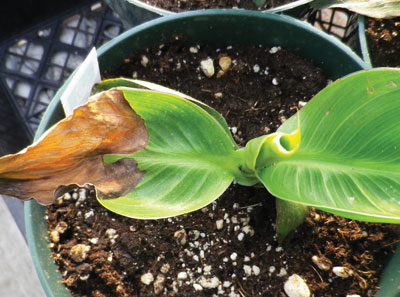 |
|
| Early signs of trouble. Advertisement
|
I am in this business of diagnosing problems and there are always challenges to diagnose with confidence, come up with solutions and suggest strategies to solve the problem right away.
This is important when plants are timed for sale in the May to June time period.
The problems I usually see and diagnose range from being pH related, to cold temperature issues and nutrient deficiencies. However, it was the damage due to the presence of herbicides in water that were in the forefront for growers I visited in Alberta.
But the journey to having a satisfied or grateful grower has some ups and down. I will describe three cases of damage due to herbicides.
THREE EXAMPLES OF HERBICIDES IN THE WATER
■ Take the case of this grower who e-mailed me pictures of his bedding plants with the following description:
I believe the problem started with the mandevilla and is progressing from there. I thought it was plant stress from being roughly handled on the way here (some plants were out of the plug tray even), and then held for an extra couple of weeks before we transplanted them. I also believed that they would grow out of it, but they were very slow growing and new leaves are also showing a sign of problems.
The Dragonwings were the next to really show problems, and again that was right after transplanting. So I waited to see if it would grow out of it, and, same as the others, the new leaves are also getting whatever is going on.
But in the last couple of days, there are signs of the same leaf problems in many other plants as well. I just did another walk-through, and the coleus also are showing the same problem signs. I do not see any signs of insects in the greenhouses. And it’s getting some colours/types worse than others in the same species.
What direction should I go?
When I looked at the pictures, what I saw mostly was tip/edge burn due to high transpiration stress, but my sixth sense pointed to the unusual leaf roll in the middle. I talked with the grower and made suggestions about temperature and watering.
Two weeks later, the grower phoned me to describe some leaf curling on tomatoes and I suspected that it could be a herbicide. We decided on a visit to the greenhouse because of the critical nature of diagnosing correctly and taking remedial actions. When I examined the plants on March 21, here is what I found:
The pictures show a variety of plants with symptoms of a phenoxy type of herbicide. Based on my experience, I estimated that concentrations in water were in the range of parts per billion. The damage appeared about three to four weeks after plugs were transplanted.
WHAT COULD BE THE SOURCE OF THE HERBICIDE?
■ The grower could not come up with an answer because the dugout location was on his property and there was not much runoff water from adjacent fields. Spray drift was not possible in March because field spraying had not started.
This left us scratching our heads, especially me. I knew I was not wrong and plants were telling the truth.
Finally, the grower recalled that he did use a herbicide last year around the dugout to control weeds. Luckily, the grower had kept good records and we found out that it was Curtail M herbicide. This herbicide has the active ingredients of Clopyralid and MCPA.
Once it was determined that a herbicide was involved, the following steps were taken to turn the crop around. Here is what we did and what happened on our way to recovery:
- Charcoal filters were installed as soon as possible. We found a supplier of charcoal filters with industry experience, and figured out the amount of water needed to determine the filter capacity.
- Activated charcoal was applied to pots, so that any herbicide in the growing medium could be tied up. This was done a day later and the grower’s comment was that staff did not like it. It was very powdery and static, but did treat all the pots.
- It was decided to use well water, which has higher sodium levels, on the site. More than 100 ppm of sodium is considered high for this purpose. My estimation was that we could use it about four to six times with good leaching every time. After the installation of charcoal filters, the well water can be mixed at certain ratios.
- Bioassays were set up by using lentils or tomato plants.
What happened next was quite interesting and challenging. Four litres of water were sent for lab analysis just to confirm the presence of the herbicides mentioned earlier.
WHAT CAN HAPPEN WITH A MIX-UP IN THE LAB
■ Labs always want to know what package should be used for analysis. I always tell them to evaporate or condense the water from four litres to one litre so that we can mimic what happened inside the plant. This instruction was missed and the package selected reflected more on multi-pesticide residues and neutral herbicides in the water. When the results came back, I did not see Clopyralid and MCPA. So another sample was sent with instructions to condense water from four litres to one litre and conduct an “acid herbicide” test.
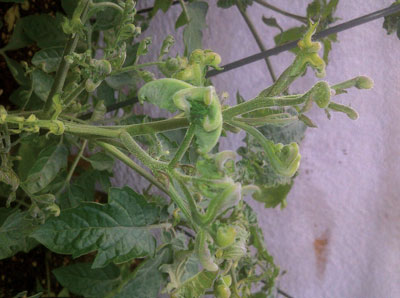 |
|
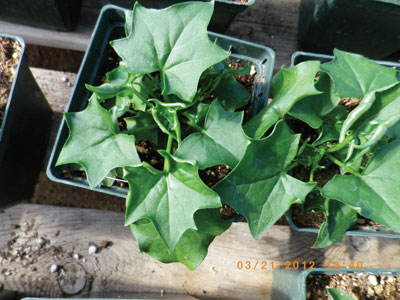 |
|
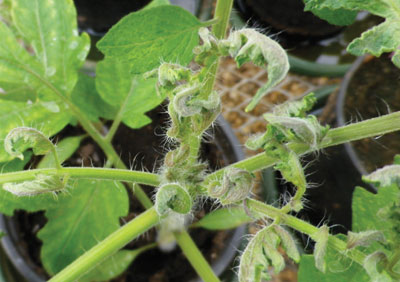 |
|
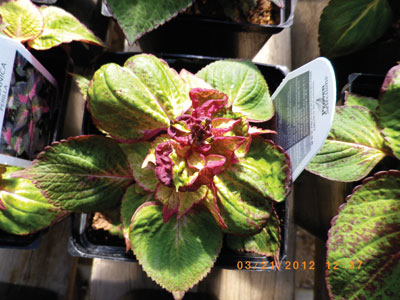 |
|
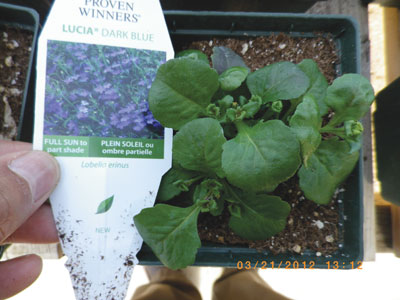 |
|
| Plants showing problems associated with herbicide damage.
|
In the meantime, the grower was curious as to why there was no herbicide detected by the lab? Maybe there was no herbicide present in the water, although plants were recovering after charcoal filtration.
Finally, the results came in as “acid herbicides” and there were 0.5 parts per billion (ppb) of Clopyralid and 0.3 ppb of MCPA, thus confirming the diagnosis.
The grower was satisfied with the diagnosis and the results achieved. The crop recovered and was successfully marketed.
The grower was provided with more information about the behaviour of these herbicides in water. It is likely going to stay in the water for at least a year; it may be diluted due to rainwater and snow, but bioassays will still need to be conducted regularly.
THE BENEFITS OF BELONGING TO A GROWER ASSOCIATION
■ I would like to point out the benefits of belonging to an association. Getting problems diagnosed is one of the advantages offered by the Alberta Greenhouse Growers Association as part of its membership and this grower was quite grateful for this.
A point I want to add is that many growers cannot easily understand lab results. For example µg/L and “surrogate” are two terms used in the analysis report. We can note here that µg/L means “micrograms of the chemical,” a herbicide in this case, in one litre of water. One litre is one kilogram (1,000 grams), which is 1,000,000 milligrams or 1,000,000,000 micrograms (parts per billion).
Simply stated, µg/L is parts per billion, which of course is a very low concentration but enough to cause problems for the plants we are growing.
The term “surrogate” means that during analysis, a standard is introduced for comparison and if the results are showing as a percentage recovery, it means that the instrument is working properly.
A TOMATO CROP UNDER PRESSURE
■ While I was writing this article in the middle of May, when bedding plants were ready for sale, a grower e-mailed me the following:
Hi Dr. Mirza. My tomatoes have a problem. The top growth is distorted, looks like herbicide damage but is not. There have been no herbicides nearby. These are in hanging baskets and 606 packs.
Any ideas what I can do?
Now, the grower “hoped” it was not a herbicide because “there have been no herbicides nearby.” I went into a “panic” mode because the symptoms are definitely due to a herbicide, and my suspicion was leaning more towards Picloram.
Notice how thickened the top growth is in the top right picture at left? I describe it as a “fist.” I phoned the grower and said that we were dealing with a herbicide and that the time is quite critical.
The tough questions always are what can be done at this stage. In this case, I advised the grower to bring in water from a known source, install charcoal filters, cut this growth off, apply activated charcoal, and hope that plants recover and are saleable. The lab results came back with 10 ppb of 2,4-D and 1.1 ppb of Picloram.
The grower switched to a different source of water and charcoal filters
were installed.
Consider the third case where a researcher bought a commercially available soil blend to conduct an experiment. A few days later he called me to look at his plants because something was “weird.”
I was sure that it was a herbicide problem. There was further evidence that the symptoms were not present in other types of soilless media used in the study. I brought this to the attention of the place where this growing medium was bought. The concern was noted because this batch of soil was on the shelves and there was the potential of consumer complaints.
This was a good example where a well-known company used soil without thoroughly testing it and the herbicide got into the system. I got an e-mail from this company saying they are going to investigate the matter further. The bag contained the following message: “Don’t use this soil in containers.”
Much greater awareness is needed that there is the potential of herbicides getting into our water supply through the use of contaminated soil or through drift sprays as well. Hopefully, the information provided in this article will increase such awareness, and economic losses can be avoided.
Dr. Mirza can be reached at drmirzaconsultants@gmail.com.
Print this page